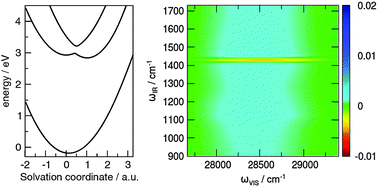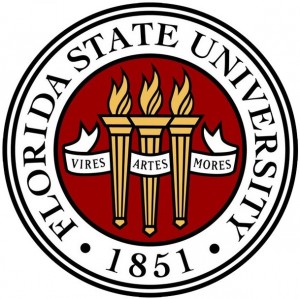PCCP record Impact Factor of 4.49
Bunsentagung 2015 – Poster Prize Winners
The 114th General Assembly of the German Bunsen Society for Physical Chemistry, Bunsentagung 2015, was held on 14-16th May 2015 in Bochum, Germany. PCCP were proud to award 16 poster prizes that were presented by Professor Joachim Sauer of Humboldt University of Berlin (pictured).
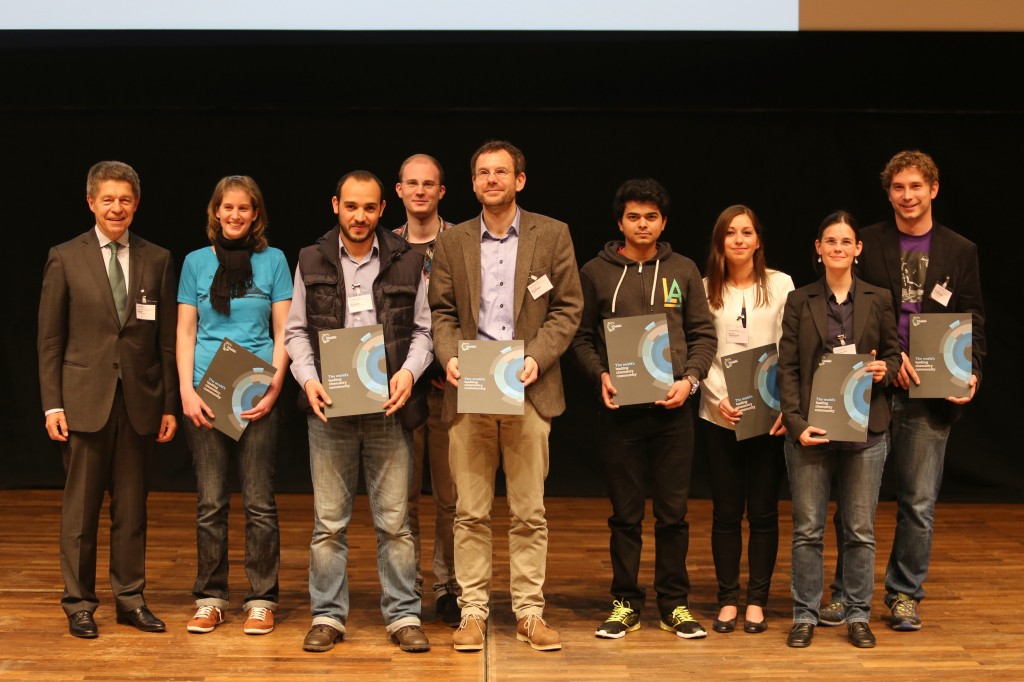 |
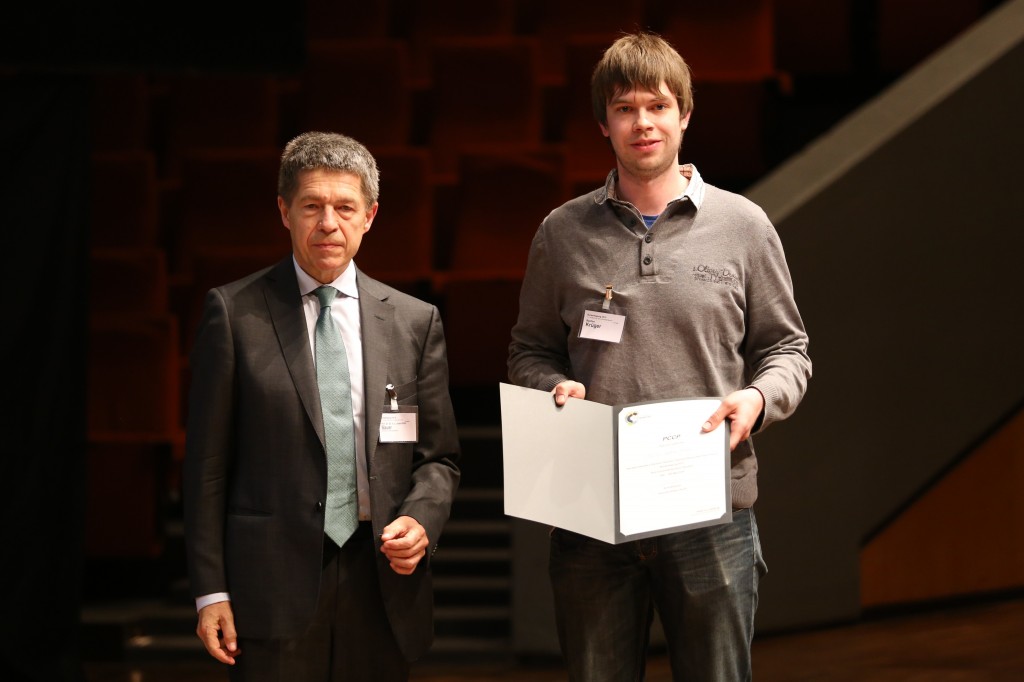 |
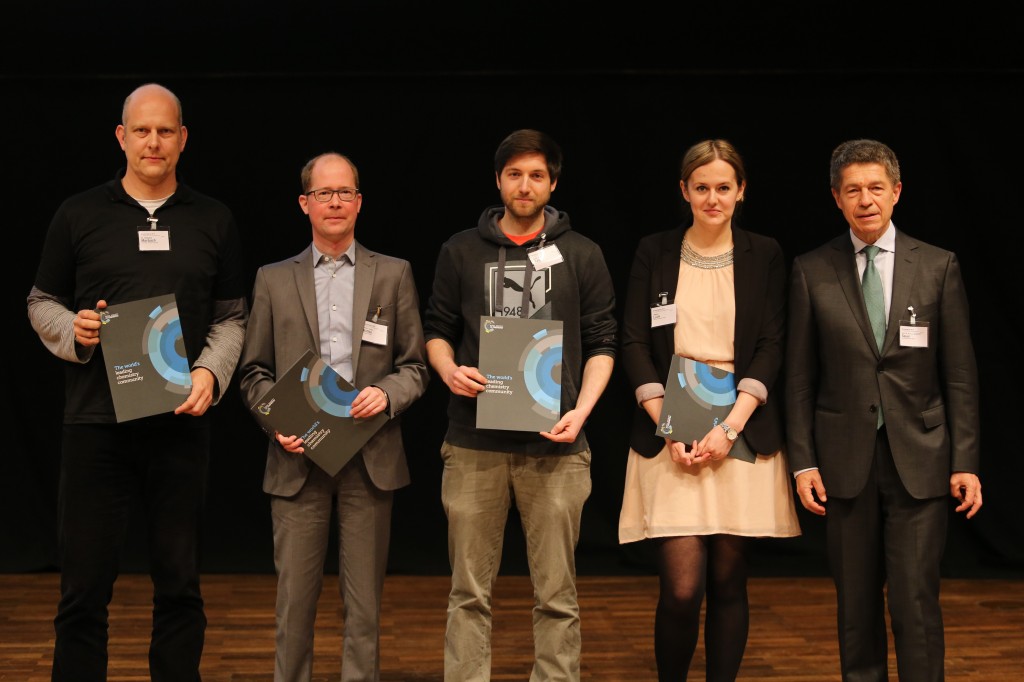 |
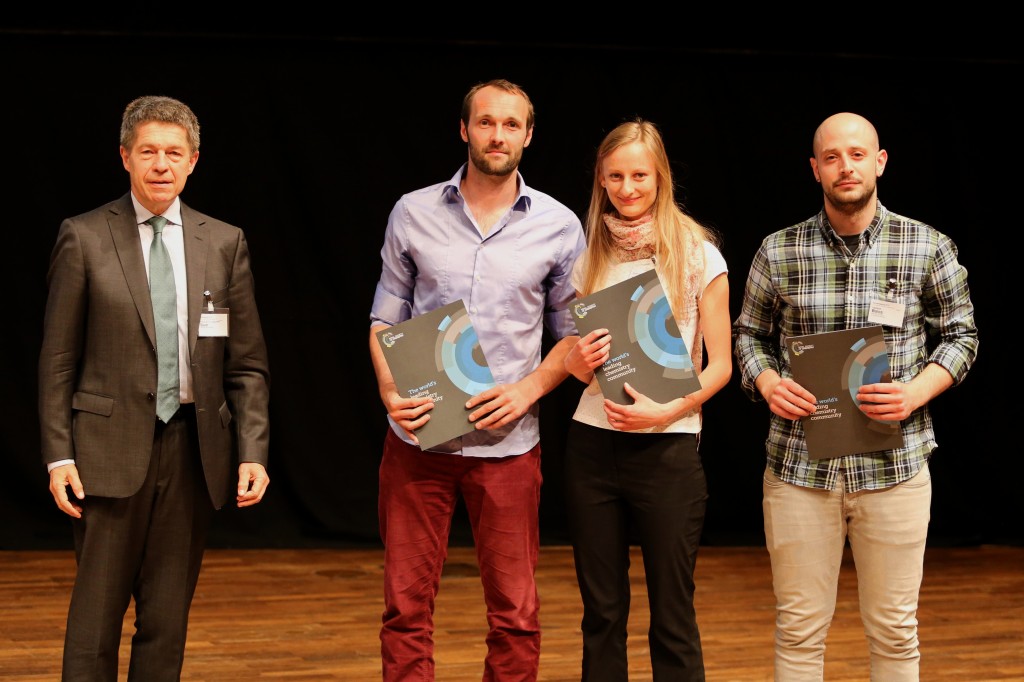 |
Bunsentagung 2015 Poster Prize Winners:
Vasileios Balos, MPI for Polymer Research, Mainz/D
Andre Fielicke, TU Berlin/D
Stefan Frittmann, Karlsruhe Institute of Technology/D
Norah Heinz, Universität zu Köln, Germany
Max Kauer, Ruhr-Universität Bochum/D
Dr Tilman Kottke, Universität Bielefeld/D
Bastian Kruger, Universität Göttingen/D
Svenja Maria Janke, Universität Göttingen/D
Jessica Luck, Helmholtz-Institut Ulm für elektrochemische Energiespeicherung/D
Dr Hubertus Marbach, Universität Erlangen-Nürnberg/D
Dr Konrad Meister, FOM Institute AMOLF, Amsterdam/NL
Suraj Naskar, Universität Hannover/D
Ibrahim Sadiek, Universität Kiel/D
Dominik Spiegel, Universität Düsseldorf/D
Anke Stamm, TU Kaiserslautern/D
Banu Yesilyurt, Universität Köln/D
Theoretical chemistry developments: from electronic structure to simulations
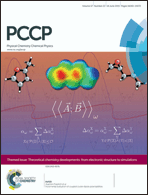 |
PCCP would like to introduce this week’s themed issue that explores theoretical chemistry, ranging from electronic structure theory to molecular dynamics simulations. ‘Theoretical chemistry developments: from electronic structure to simulations‘ aims to give an overview of developments in the field and give a voice to the younger researchers who are shaping the future through the development of theoretical tools that will dominate the field of quantum chemistry.
The guest editors of the issue are Barbara Kirchner (University of Bonn) and Frank Neese (Max-Planck Institute for Chemical Energy Conversion) and their editorial can be viewed for free untill 30th July 2015, along with this selection of articles: Simulations of room temperature ionic liquids: from polarizable to coarse-grained force fields, Mathieu Salanne, Phys. Chem. Chem. Phys., 2015,17, 14270-14279, DOI: 10.1039/C4CP05550K Towards an ab initio description of the optical spectra of light-harvesting antennae: application to the CP29 complex of photosystem II, Sandro Jurinovich, Lucas Viani, Ingrid G. Prandi, Thomas Renger and Benedetta Mennucci, Phys. Chem. Chem. Phys., 2015,17, 14405-14416, DOI: 10.1039/C4CP05647G How simple is too simple? Computational perspective on importance of second-shell environment for metal-ion selectivity, Ondrej Gutten and Lubomír Rulíšek, Phys. Chem. Chem. Phys., 2015,17, 14393-14404, DOI: 10.1039/C4CP04876H |
Recent HOT articles in PCCP
Check out the following HOT articles, these have all been made free to access for a limited time:
Structure and energetics of the anisole–Arn (n = 1, 2, 3) complexes: high-resolution resonant two-photon and threshold ionization experiments, and quantum chemical calculations
Federico Mazzoni, Maurizio Becucci, Jan Řezáč, Dana Nachtigallová, François Michels, Pavel Hobza and Klaus Müller-Dethlefs
Phys. Chem. Chem. Phys., 2015, 17, 12530-12537
DOI: 10.1039/C5CP01166C
Oxygen diffusion in single crystal barium titanate
Markus Kessel, Roger A. De Souza and Manfred Martin
Phys. Chem. Chem. Phys., 2015, 17, 12587-12597
DOI: 10.1039/C5CP01187F
Vibrational control of electron transfer reactions: A feasibility study for the fast coherent transfer regime
P. Antoniou, Z. Ma, P. Zhang, D. N. Beratan and S. S. Skourtis
Phys. Chem. Chem. Phys., 2015, Advance Article
DOI: 10.1039/C5CP00610D
Three-dimensional sp2-hybridized carbons consisting of orthogonal nanoribbons of graphene and net C
Meng Hu, Xu Dong, Bingchao Yang, Bo Xu, Dongli Yu and Julong He
Phys. Chem. Chem. Phys., 2015, 17, 13028-13033
DOI: 10.1039/C5CP01621E
Two-dimensional electronic-vibrational spectra: modeling correlated electronic and nuclear motion
F. Terenziani and A. Painelli
Phys. Chem. Chem. Phys., 2015, 17, 13074-13081
DOI: 10.1039/C5CP01485A
Self-assembly and coverage dependent thermally induced conformational changes of Ni(II)-meso-tetrakis (4-tert-butylphenyl) benzoporphyrin on Cu(111)
Liang Zhang, Michael Lepper, Michael Stark, Dominik Lungerich, Norbert Jux, Wolfgang Hieringer, Hans-Peter Steinrück and Hubertus Marbach
Phys. Chem. Chem. Phys., 2015, 17, 13066-13073
DOI: 10.1039/C5CP01490E
Gas-phase chemistry of technetium carbonyl complexes
Yang Wang, Zhi Qin, Fang-Li Fan, Hiromitsu Haba, Yukiko Komori, Shi-Wei Cao, Xiao-Lei Wu and Cun-Min Tan
Phys. Chem. Chem. Phys., 2015, 17, 13228-13234
DOI: 10.1039/C5CP00979K
Generating hydrated electrons through photoredox catalysis with 9-anthrolate
Christoph Kerzig and Martin Goez
Phys. Chem. Chem. Phys., 2015, 17, 13829-13836
DOI: 10.1039/C5CP01711D
Hybrid nanostructures for SERS: materials development and chemical detection
Sara Fateixa, Helena I. S. Nogueira and Tito Trindade
Phys. Chem. Chem. Phys., 2015, Advance Article
DOI: 10.1039/C5CP01032B
Is seven the minimum number of water molecules per ion pair for assured biological activity in ionic liquid–water mixtures?
Hiroyuki Ohno, Kyoko Fujita and Yuki Kohno
Phys. Chem. Chem. Phys., 2015, Advance Article
DOI: 10.1039/C5CP00768B
Awards for Achievements in Physical Chemistry
PCCP is pleased to announce that the winners of the 2014 awards for achievements in physical chemistry, received their prizes on 5th May 2015 at the University of Birmingham. Professor Helen Fielding of UCL presented these awards on behalf of the Faraday Division.The winners of the 2015 awards have now also been announced.
The 2014 winners:
Harrison-Meldola Memorial Prizes 2014 Winner – David Glowacki, University of Bristol/Stanford University
Bourke Award 2014 Winner – Professor Ann McDermott, Columbia University
Chemical Dynamics Award 2014 Winner – Professor Andrew Orr-Ewing, University of Bristol
Liversidge Award 2014 Winner – Professor Michael Ashfold, University of Bristol
 |
Left: Andrew Orr-Ewing, Helen Fielding, David Golwacki and Michael Ashfold
Right: Ann McDermott and Helen Fielding |
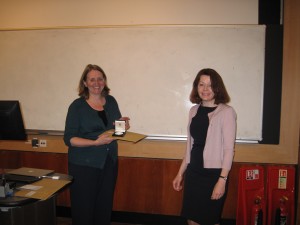 |
PCCP Tulip2015 Awards
We are delighted to announce the winners of the PCCP Tulip2015 awards that were given at the Tulip2015 Summer School on Modern Developments in Spectroscopy in Noordwijk in the Netherlands. This year, there were two winners of the prize, best presentation went to Sana Habka of CEA Saclay, France for her poster on “Gas Phase Spectroscopy of Zwitterionic Complexes” and best layout went to Ana Krin of Max-Planck-Institut für Struktur und Dynamik der Materie, Hamburg, Germany for her poster on “Enantiomer Identification in Mixtures Using Broadband Microwave Spectroscopy”. The winners each received a certificate and a cash prize.
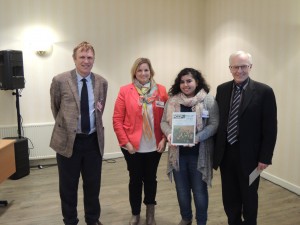 |
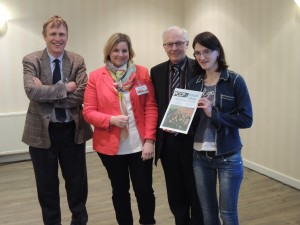 |
Pictured (left): Prof. Wybren Jan Buma (co-chair of the Tulip Summer School), Prof. Jennifer Herek (co-chair of the Tulip VI Summer School), Sana Habka (PCCP Poster prize winner for best presentation) and Prof. Paul Corkum (lecturer at Tulip2015 and presenting the award on behalf of the committee of all 6 Tulip lecturers).
Pictured (right): Prof. Wybren Jan Buma, Prof. Jennifer Herek, Prof. Paul Corkum, and Ana Krin (PCCP Poster prize winner for best poster layout/text).
Recent HOT PCCP Articles
Check out the following HOT articles, these have all been made free to access for a limited time:
Hidden photoinduced reactivity of the blue fluorescent protein mKalama1
Russell B. Vegh, Dmitry A. Bloch, Andreas S. Bommarius, Michael Verkhovsky, Sergei Pletnev, Hideo Iwaï, Anastasia V. Bochenkova and Kyril M. Solntsev
Phys. Chem. Chem. Phys., 2015, Advance Article
DOI: 10.1039/C5CP00887E, Paper
Rayleigh light scattering properties of atmospheric molecular clusters consisting of sulfuric acid and bases
Jonas Elm, Patrick Norman and Kurt V. Mikkelsen
Phys. Chem. Chem. Phys., 2015, Advance Article
DOI: 10.1039/C5CP01012H, Paper
Comparison of the plasmonic performances between lithographically fabricated and chemically grown gold nanorods
Lei Shao, Yuting Tao, Qifeng Ruan, Jianfang Wang and Hai-Qing Lin 
Phys. Chem. Chem. Phys., 2015,17, 10861-10870
DOI: 10.1039/C5CP00715A, Paper
Order and disorder around Cr3+ in chromium doped persistent luminescent AB2O4 spinels
Neelima Basavaraju, Kaustubh R. Priolkar, Didier Gourier, Aurélie Bessière and Bruno Viana
Phys. Chem. Chem. Phys., 2015,17, 10993-10999
DOI: 10.1039/C5CP01097G, Paper
Physicochemical design and analysis of self-propelled objects that are characteristically sensitive to environments
Satoshi Nakata, Masaharu Nagayama, Hiroyuki Kitahata, Nobuhiko J. Suematsu and Takeshi Hasegawa
Phys. Chem. Chem. Phys., 2015,17, 10326-10338
DOI: 10.1039/C5CP00541H, Perspective
Strong field laser control of photochemistry
Ignacio R. Solá, Jesús González-Vázquez, Rebeca de Nalda and Luis Bañares
Phys. Chem. Chem. Phys., 2015, Advance Article
DOI: 10.1039/C5CP00627A, Perspective
Nuclear quantum tunnelling in enzymatic reactions – an enzymologist’s perspective 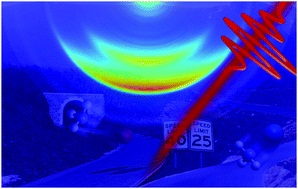
Linus O. Johannissen, Sam Hay and Nigel S. Scrutton
Phys. Chem. Chem. Phys., 2015, Advance Article
DOI: 10.1039/C5CP00614G, Perspective
Internal heavy atom effects in phenothiazinium dyes: enhancement of intersystem crossing via vibronic spin–orbit coupling
Angela Rodriguez-Serrano, Vidisha Rai-Constapel, Martha C. Daza, Markus Doerr and Christel M. Marian
Phys. Chem. Chem. Phys., 2015, Advance Article
DOI: 10.1039/C5CP00194C, Paper
2015 PCCP – Chemical Society of Japan Prizes
We are delighted to announce the winners of the 2015 PCCP Prizes for Outstanding Achievement of Young Scientists in Physical Chemistry and Chemical Physics. These were awarded by Dr Robert Parker (CEO of the Royal Society of Chemistry) and Dr Anna Simpson (PCCP Editor) at a prize ceremony held at the 95th Annual Meeting of the Chemical Society of Japan at Nihon University, College of Science and Technology on 27th March. The winners each received a commemorative book, a PCCP Prize certificate and a financial award.
The prizewinners:
Dr. Manabu Kanno of Tohoku University for his work on “Laser Control of Attosecond Electron Dynamics Nonadiabatically Coupled with Femtosecond Molecular Vibrations”
Dr. Michio Yamada of Tokyo Gakugei University for his work on”Unveiling the Unique Structures and Chemical Reactivities of Endohedral Metallofullerenes”
Dr. Taniyuki Furuyama of Tohoku University) for his work on “Development of azaporphyrin complexes with main-group elements“
Why does a lobster change colour when you cook it?
When you cook a lobster you will see a striking colour transformation from dark blue to orange-pink and until now, the cause for this has been subject to debate. Although the presence of astaxanthin, a carotenoid, is known to be responsible for the change, a recent PCCP article has shed light on exactly how.
In an international collaboration, Dr. John Halliwell at the University of Manchester and his group, have found that astaxanthin is present as a negatively charged enolate ion in the uncooked blue lobster. On heating, the enolate bonds break down and release orange-pink astaxanthin causing the colour change. This discovery has been made as a result of the combined interdisciplinary expertise in physical organic, biological and theoretical chemistry as well as spectroscopy.
Interested to know more?
Read the full article in Chemistry World by William Bergius.
Or, take a look at the original Open Access research article:
On the origin and variation of colours in lobster carapace, Shamima Begum, Michele Cianci, Bo Durbeej, Olle Falklöf, Alfons Hädener, John R. Helliwell, Madeleine Helliwell, Andrew C. Regan and C. Ian F. Watt, Phys. Chem. Chem. Phys., 2015, DOI: 10.1039/C4CP06124A
The 8th Annual Nanoscience Technology Symposium
PCCP is delighted to announce that the journal is sponsoring the 8th Annual Nanoscience Technology Symposium, NanoFlorida2015, to be held on 12th-15th May, at Florida State University, USA.
Topics to be covered include:
- Synthesis and characterization of novel materials
- Optical and electronic properties
- Integration into photovoltaic and light emitting devices
- Functionalization strategies
- Sensor design
- Imaging of cells and tissues
- Drug delivery vehicles
Visit the website for further information and to submit an abstract, the abstract submission deadline is 31st March.












